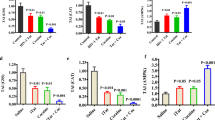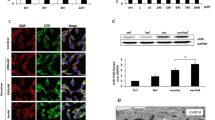Abstract
Addictive stimulant drugs, such as cocaine, are known to increase the risk of exposure to HIV-1 infection and hence predispose towards the development of AIDS. Previous findings suggested that the combined effect of chronic cocaine administration and HIV-1 infection enhances cell death. Neuronal survival is highly dependent on the health of mitochondria providing a rationale for assessing mitochondrial integrity and functionality following cocaine treatment, either alone or in combination with the HIV-1 viral protein Tat, by monitoring ATP release and mitochondrial membrane potential (ΔΨm). Our results indicate that exposing human and rat primary hippocampal neurons to cocaine and HIV-1 Tat synergistically decreased both mitochondrial membrane potential and ATP production. Additionally, since previous studies suggested HIV-1 infection alters autophagy in the CNS, we investigated how HIV-1 Tat and cocaine affect autophagy in neurons. The results indicated that Tat induces an increase in LC3-II levels and the formation of Parkin-ring-like structures surrounding damaged mitochondria, indicating the possible involvement of the Parkin/PINK1/DJ-1 (PPD) complex in neuronal degeneration. The importance of mitochondrial damage is also indicated by reductions in mitochondrial membrane potential and ATP content induced by HIV-1 Tat and cocaine.





Similar content being viewed by others
References
Aksenov MY, Aksenova MV, Nath A, Ray PD, Mactutus CF, Booze RM (2006) Cocaine-mediated enhancement of Tat toxicity in rat hippocampal cell cultures: the role of oxidative stress and D1 dopamine receptor. Neurotoxicology 27:217–228
Ashrafi G, Schwarz TL (2015) PINK1- and PARK2-mediated local mitophagy in distal neuronal axons. Autophagy 11:187–189
Attwell D, Laughlin SB (2001) An energy budget for signaling in the grey matter of the brain. J Cereb Blood Flow Metab 21:1133–1145
Avdoshina V, Bachis A, Mocchetti I (2013) Synaptic dysfunction in human immunodeficiency virus type-1- positive subjects: inflammation or impaired neuronal plasticity? J Intern Med 273:454–465
Barroso-Moguel R, Mendez-Armenta M, Villeda-Hernandez J, Nava-Ruiz C, Santamaria A (2002) Brain lesions induced by chronic cocaine administration to rats. Prog Neuropsychopharmacol Biol Psychiatry 26:59–63
Bilgrami M, O’Keefe P (2014) Neurologic diseases in HIV-infected patients. Handb Clin Neurol 121:1321–1344
Bruce-Keller AJ, Chauhan A, Dimayuga FO, Gee J, Keller JN, Nath A (2003) Synaptic transport of human immunodeficiency virus-Tat protein causes neurotoxicity and gliosis in rat brain. J Neurosci 23:8417–8422
Cai Q, Zakaria HM, Simone A, Sheng ZH (2012) Spatial Parkin translocation and degradation of damaged mitochondria via mitophagy in live cortical neurons. Curr Biol 22:545–552
Carey AN, Sypek EI, Singh HD, McLaughlin JP (2012) Expression of HIV-Tat protein is associated with learning and memory deficits in the mouse. Behav Brain Res 229:48–56
Chu C, Selwyn PA (2011) Complications of HIV infection: a systems-based approach. Am Fam Physician 83:395–406
Connolly CG, Bell RP, Foxe JJ, Garavan H (2013) Dissociated grey matter changes with prolonged addiction and extended abstinence in cocaine users. PLoS One 8:e59645
Dahal S, Chitti SV, Nair MP, Saxena SK (2015) Interactive effects of cocaine on HIV infection: implication in HIV-associated neurocognitive disorder and neuroAIDS. Front Microbiol 6:931
Darbinyan A, Kaminski R, White MK, Darbinian N, Khalili K (2013) Isolation and propagation of primary human and rodent embryonic neural progenitor cells and cortical neurons. Methods Mol Biol 1078:45–54
Dupuis L (2014) Mitochondrial quality control in neurodegenerative diseases. Biochimie 100:177–183
El-Khoury V, Pierson S, Szwarcbart E, Brons NH, Roland O, Cherrier-De Wilde S, Plawny L, Van Dyck E, Berchem G (2014) Disruption of autophagy by the histone deacetylase inhibitor MGCD0103 and its therapeutic implication in B-cell chronic lymphocytic leukemia. Leukemia 28:1636–1646
Ensoli B, Buonaguro L, Barillari G, Fiorelli V, Gendelman R, Morgan RA, Wingfield P, Gallo RC (1993) Release, uptake, and effects of extracellular human immunodeficiency virus type 1 Tat protein on cell growth and viral transactivation. J Virol 67:277–287
Friedman H, Pross S, Klein TW (2006) Addictive drugs and their relationship with infectious diseases. FEMS Immunol Med Microbiol 47:330–342
Ghavami S, Shojaei S, Yeganeh B, Ande SR, Jangamreddy JR, Mehrpour M, Christoffersson J, Chaabane W, Moghadam AR, Kashani HH, Hashemi M, Owji AA, Łos MJ (2014) Autophagy and apoptosis dysfunction in neurodegenerative disorders. Prog Neurobiol 112:24–49
Grenier K, McLelland GL, Fon EA (2013) Parkin- and PINK1-dependent mitophagy in neurons: will the real pathway please stand up? Front Neurol 4:100
Harricharan R, Thaver V, Russell VA, Daniels WM (2015) Tat-induced histopathological alterations mediate hippocampus-associated behavioural impairments in rats. Behav Brain Funct 11:3
Joshi DC, Bakowska JC (2011) Determination of mitochondrial membrane potential and reactive oxygen species in live rat cortical neurons. J Vis Exp 51:e2704
Katsuragi Y, Ichimura Y, Komatsu M (2015) p62/SQSTM1 functions as a signaling hub and an autophagy adaptor. FEBS J 282:4672–4678
Klionsky DJ, Abdelmohsen K, Abe A, Abedin MJ, Abeliovich H, Acevedo Arozena A, Adachi H et al (2016) Guidelines for the use and interpretation of assays for monitoring autophagy (3rd edition). Autophagy 12:1–222
Kovalevich J, Langford D (2012) Neuronal toxicity in HIV CNS disease. Futur Virol 7:687–698
Kruman I, Nath A, Mattson MP (1998) HIV-1 protein Tat induces apoptosis of hippocampal neurons by a mechanism involving caspase activation, calcium overload, and oxidative stress. Exp Neurol 154:276–288
Langford D, Masliah E (2002) Role of trophic factors on neuroimmunity in neurodegenerative infectious diseases. J Neurovirol 8:625–638
Lecoeur H, Borgne-Sanchez A, Chaloin O, El-Khoury R, Brabant M, Langonné A, Porceddu M, Brière JJ, Buron N, Rebouillat D, Péchoux C, Deniaud A, Brenner C, Briand JP, Muller S, Rustin P, Jacotot E (2012) HIV-1 Tat protein directly induces mitochondrial membrane permeabilization and inactivates cytochrome c oxidase. Cell Death Dis 3:e282
Lee CW, Peng HB (2008) The function of mitochondria in presynaptic development at the neuromuscular junction. Mol Biol Cell 19:150–158
McArthur JC, Brew BJ, Nath A (2005) Neurological complications of HIV infection. Lancet Neurol 4:543–555
Mizushima N, Yoshimori T (2007) How to interpret LC3 immunoblotting. Autophagy 3:542–545
Mocchetti I, Bachis A, Avdoshina V (2012) Neurotoxicity of human immunodeficiency virus-1: viral proteins and axonal transport. Neurotox Res 21:79–89
Mukerjee R, Deshmane SL, Fan S, Del Valle L, White MK, Khalili K, Amini S, Sawaya BE (2008) Involvement of the p53 and p73 transcription factors in neuroAIDS. Cell Cycle 7:2682–2690
Régulier EG, Reiss K, Khalili K, Amini S, Zagury JF, Katsikis PD, Rappaport J (2004) T-cell and neuronal apoptosis in HIV infection: implications for therapeutic intervention. Int Rev Immunol 23:25–59
Seirafi M, Kozlov G, Gehring K (2015) Parkin structure and function. FEBS J 282:2076–2088
Sen S, Kaminiski R, Deshmane S, Langford D, Khalili K, Amini S, Datta PK (2015) Role of hexokinase-1 in the survival of HIV-1-infected macrophages. Cell Cycle 14:980–989
Sheng ZH (2014) Mitochondrial trafficking and anchoring in neurons: new insight and implications. J Cell Biol 204:1087–1098
Stavros K, Simpson DM (2014) Understanding the etiology and management of HIV-associated peripheral neuropathy. Curr HIV/AIDS Rep 11:195–201
Stevens PR, Gawryluk JW, Hui L, Chen X, Geiger JD (2014) Creatine protects against mitochondrial dysfunction associated with HIV-1 Tat-induced neuronal injury. Curr HIV Res 12:378–387
Tan IL, Smith BR, von Geldern G, Mateen FJ, McArthur JC (2012) HIV-associated opportunistic infections of the CNS. Lancet Neurol 11:605–617
Tanida I, Ueno T, Kominami E (2008) LC3 and autophagy. Methods Mol Biol 445:77–88
Torres-Muñoz J, Stockton P, Tacoronte N, Roberts B, Maronpot RR, Petito CK (2001) Detection of HIV-1 gene sequences in hippocampal neurons isolated from postmortem AIDS brains by laser capture microdissection. J Neuropathol Exp Neurol 60:885–892
Verstreken P, Ly CV, Venken KJ, Koh TW, Zhou Y, Bellen HJ (2005) Synaptic mitochondria are critical for mobilization of reserve pool vesicles at Drosophila neuromuscular junctions. Neuron 47:365–378
Wayman WN, Chen L, Persons AL, Napier TC (2015) Cortical consequences of HIV-1 Tat exposure in rats are enhanced by chronic cocaine. Curr HIV Res 13:80–87
Yamaguchi M, Suzuki T, Seki T, Namba T, Liu J, Hori T, Shiga T (2005) Decreased cell proliferation in the dentate gyrus of rats after repeated administration of cocaine. Synapse 58:63–71
Yamamoto A, Tagawa Y, Yoshimori T, Moriyama Y, Masaki R, Tashiro Y (1998) Bafilomycin A1 prevents maturation of autophagic vacuoles by inhibiting fusion between autophagosomes and lysosomes in rat hepatoma cell line, H-4-II-E cells. Cell Struct Funct 23:33–42
Acknowledgements
We thank Dr. Manish Gupta and other past and present members of the Department of Neuroscience and Center for Neurovirology for their insightful discussion and sharing of ideas and reagents. This study utilized services offered by Lewis Katz School of Medicine Comprehensive NeuroAIDS Center at Temple University. This work was supported by grants P01 DA037830 and P30 MH092177 awarded to KK.
Author information
Authors and Affiliations
Corresponding author
Ethics declarations
All applicable international, national, and/or institutional guidelines for the care and use of animals were followed. All studies were reviewed and approved by the Katz School of Medicine IACUC.
No human subjects were used in these studies.
Funding
This study was funded by grant number P01DA037830 and P30MH092177 awarded to K. Khalili by NIH.
Conflict of Interest
F.I. De Simone declares that she has no conflict of interest.
N. Darbinian declares that she has no conflict of interest.
S. Amini declares that she has no conflict of interest.
M.K. White declares that he has no conflict of interest.
J. Elrod declares that he has no conflict of interest.
P. Datta declares that he has no conflict of interest.
D. Langford declares that she has no conflict of interest.
K. Khalili declares that he has no conflict of interest.
Rights and permissions
About this article
Cite this article
De Simone, F.I., Darbinian, N., Amini, S. et al. HIV-1 Tat and Cocaine Impair Survival of Cultured Primary Neuronal Cells via a Mitochondrial Pathway. J Neuroimmune Pharmacol 11, 358–368 (2016). https://doi.org/10.1007/s11481-016-9669-6
Received:
Accepted:
Published:
Issue Date:
DOI: https://doi.org/10.1007/s11481-016-9669-6




